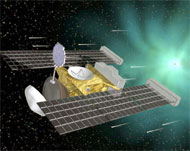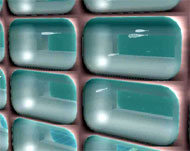Hunting space dust
Nasa’s Stardust space capsule, which returned to Earth on Sunday after a seven-year journey, made use of a revolutionary new material designed to capture and preserve minute particles of extraterrestrial dust.

The material, known as aerogel, is an extremely light silicon-based substance 99.8% of which is made up of nothing at all.
With a ghostly smoky blue appearance, it is 1000 times less dense than glass – another silicon-based solid – and has been listed by the Guinness Book of Records as the world’s lightest solid.
It is remarkable in many other ways, including its strength and its extremely low thermal conductivity.
Experiments have shown, for example, how a sheet of aerogel can prevent a flower from burning or wax crayons from melting when held over the heat of a flame from a Bunsen burner.
Because space dust particles travel at around six times the speed of a rifle bullet, scientists needed a substance that could trap and hold the particles without altering their shape or chemical make-up.
Low density
Aerogel’s unique low density and super-porous structure fulfills this need by capturing the dust particles and bringing them to a relatively gradual halt.
Furthermore, because it is virtually transparent, the tiny tracks created as the space dust strikes and penetrates the gel should enable scientists to find and extract the microscopic particles themselves.
 |
|
Stardust is bringing back just a |
Amazingly, at the time Stardust was launched on its way to its comet rendezvous, scientists had no idea how to extract the particles from the aerogel.
Seven years later however, and scientists at the University of California, Berkeley, have developed what they’ve nicknamed microtweezers and micro-pickle forks to pull grains from the aerogel for detailed analysis.
On board Stardust the aerogel was mounted in a special tennis-racket shaped, double-sided array on the Stardust spacecraft, one side of which was exposed to dust from comet Wild 2 – particles originating from the origins of the solar system some 4.5 billion years ago.
Space dust sprinkling
The other side of the array was exposed to capture a sprinkling of space dust encountered during its journey – particles perhaps formed in supernova explosions far across the galaxy tens of millions of years ago.
While scientists expect the array to return with thousands of particles of comet dust, they anticipate there will be barely more than 40 submicroscopic particles of space dust – and finding them will not be easy.
 |
|
Cells of aerogel were mounted in |
Nasa and researchers at UC Berkeley have put out an appeal for hundreds of volunteers to help hunt for the particles of space dust.
Using the internet and a specially developed “virtual microscope”, trained and tested volunteers will be able scan some of the 1.5 million pictures of the aerogel for the tell-tale tracks left by the speeding dust.
With each picture covering an area smaller than a grain of salt, parallels with hunting for a needle in a haystack pale into insignificance.
Scientists leading the search say the first images should be available for volunteer particle-hunters in mid-March.
More information about the internet hunt for space dust can be found at the Stardust @ Home website: http://stardustathome.ssl.berkeley.edu/